- ABOUT US
- PROGRAM AREAS
- CONSERVATION APPROACH
- EDUCATION
- MULTIMEDIA
- to maintain the server, database, and data-entry app;
- keep daily logs of activities and issues;
- perform daily backups;
- generate end-of-cruise reports;
- general support (troubleshooting, QC'ing site data, ensuring data systems run smoothly); and
- choose a “photo of the day” for the background of the data-entry app.
Data Management on the High Seas
By Lalitha Asirvadam, CoRIS Data and Information Management Specialist
As a Data and Information Management Specialist for the Coral Reef Information System (CoRIS), I am used to looking at the results of a research project — after all files have been assembled into neatly organized "data packages". Everything can be done online, so we data managers rarely get a chance to leave the office for fieldwork like other scientists. Still, when I started at NOAA in August of 2021, I was thrilled to work in coral reef science, a subject more aligned with my interests and graduate school research than the oil spill-heavy material from my past in my home state of Texas. As excited as I was, I started this position during the pandemic, so my experience has been squeezed into a small laptop screen at home.
When presented with the opportunity to leave my new apartment in Washington D.C. and travel to the Mariana Islands to be a data manager on the NOAA Ship Rainier for a National Coral Reef Monitoring Program (NCRMP) research cruise in July 2022, I could not pass it up! Rarely does such an adventurous opportunity come along in the data management world. It also was a great learning opportunity to see the beginning of a project and how NCRMP data is collected and managed out at sea.
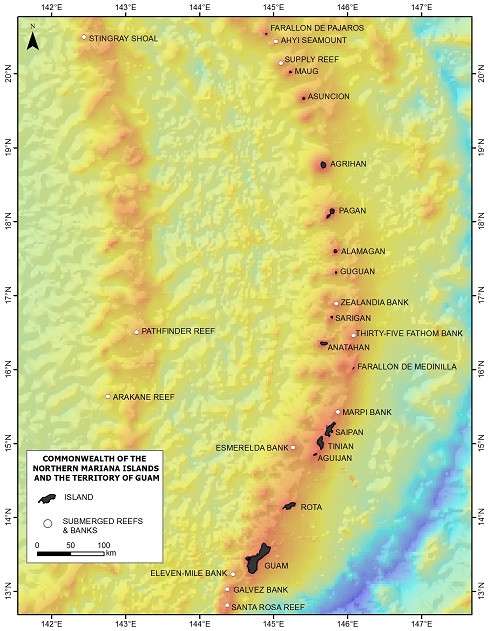
NCRMP Cruise to the Mariana Islands
After a long journey across the continental U.S. and Pacific Ocean, I boarded the NOAA ship Rainier in Guam and was ready for my first 30-day stint on a research cruise. A new group of scientists/divers also made their way to Guam for the cruise's last leg (out of seven) as the teams changed for each leg. We set out to sea the next day and headed north to Rota, the next island in the chain that makes up the Mariana Islands.
Duties Onboard
The data manager's major roles are:
Partners at the Pacific Islands Fisheries Science Center (PIFSC) trained the data managers (including me) for a few months before we set out to sea and I continued working closely with them once onboard. They designed the Mission App, a user-friendly app that allows for easy data entry on the ship, and were always just a WhatsApp call away when I had a troubleshooting crisis. I also worked closely with the Rainier's technology staff and ensured the divers could access the Mission App and connect to the ship's network and WiFi.
Dive Teams
Two science teams conducted surveys on the cruise while I was onboard-- the Fish team and the Ocean and Climate Change team. Divers performed Structure from Motion (SfM) surveys which involved taking images at intervals with a special underwater camera while using a back-and-forth swim pattern to capture corals and fish in view. These sites were selected to represent various depths, habitat types (aggregate reef, patch reef, pavement, rock and boulder, and rubble), coral cover, and diving conditions.
Cruise Life
Every evening after dinner, there was a science meeting with the ship's captain, NOAA Corps (officers who navigate the Rainier), and the science leads to discuss the operations for the next day. Discussion topics included reviewing weather and ocean conditions, choosing specific dive locations, deciding how many oxygen tanks were needed, identifying who would dive and who would drive the small boats, etc. I often attended these meetings to know the plan for the next day.
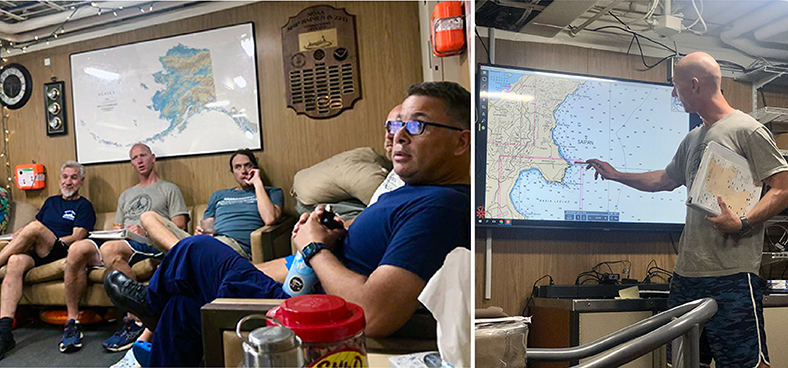
The mornings began with safety meetings on the aft, or back of the ship, where the NOAA Corps officers, deck crew, and divers would assemble to check their gear and discuss the activities and safety measures for the day. Then they would set off on the small boats, allowing them to easily maneuver around the island to specific locations. I started my mornings in the computer room, backing up the previous day's data and ensuring everything was running smoothly and ready for data entry when they returned. It was evident when that happened because the whole ship would come alive with the crew rushing to start the process of hauling the small boats back on the ship. Once onboard, each science team leader would hand their GPS units to me so I could begin uploading the coordinates and appropriate site information into the Mission App. Dinner was promptly at 5 PM, so the divers usually grabbed dinner and then began entering the data they collected for the day.
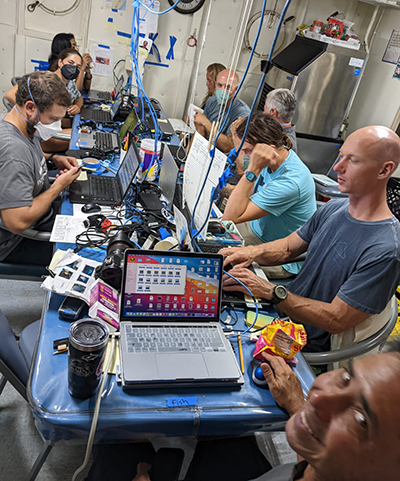
After all of the daily duties were completed, I made time for fun and often watched the sunset at the front of the ship with others, hung out in the TV room for movie night, played cards or charades, read, or joined in on video games in the galley. Then, the next morning it would start all over again. On days the Rainier was docked in-port in Guam and Saipan, the crew and I explored the local sights and snorkeled on some fantastic reefs, allowing me to see the vibrant ecosystems up close.
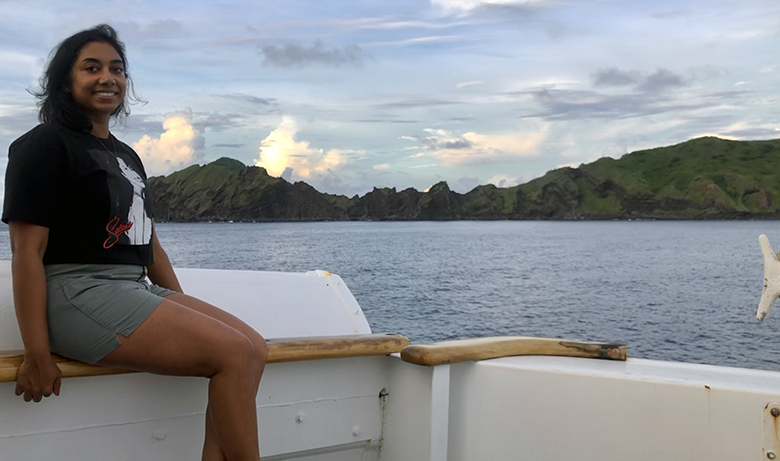
Being immersed in this experience showed me what a massive undertaking a research cruise is and how much collaboration and teamwork go into the success of a scientific mission. Seeing all the hard work during the data collection process out at sea also gave me a new appreciation and better understanding of the NCRMP data packages I review back in D.C. I hope to continue contributing to this dynamic and necessary work!
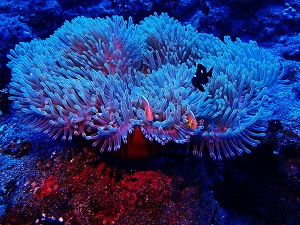
About Us

The NOAA Coral Reef Conservation Program was established in 2000 by the Coral Reef Conservation Act. Headquartered in Silver Spring, Maryland, the program is part of NOAA's Office for Coastal Management.

The Coral Reef Information System (CoRIS) is the program's information portal that provides access to NOAA coral reef data and products.
Work With US
U.S. Coral Reef Task Force
Funding Opportunities
Employment
Fellowship Program
Contracting Assistance
Graphic Identifier
Featured Stories Archive

Access the archive of featured stories here...
Feedback
Thank you for visiting NOAA’s Coral Reef Conservation Program online. Please take our website satisfaction survey. We welcome your ideas, comments, and feedback. Questions? Email coralreef@noaa.gov.
Stay Connected
Contact Us
NOAA’s Coral Reef Conservation Program
SSMC4, 10th Floor
1305 East West Highway
Silver Spring, MD 20910
coralreef@noaa.gov
